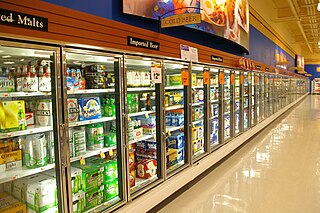
The term refrigeration denotes cooling of a space, substance or system to lower and/or maintain its temperature below the ambient one. Refrigeration is considered an artificial, or human-made, cooling method.

A steakhouse, steak house, or chophouse refers to a restaurant that specializes in steaks and chops, found mainly in North America. Modern steakhouses may also carry other cuts of meat including poultry, roast prime rib, and veal, as well as fish and other seafood.

Lamb, hogget, and mutton, generically sheep meat, are the meat of domestic sheep, Ovis aries. A sheep in its first year is a lamb and its meat is also lamb. The meat from sheep in their second year is hogget. Older sheep meat is mutton. Generally, "hogget" and "sheep meat" are not used by consumers outside Norway, New Zealand, South Africa, Scotland, and Australia. Hogget has become more common in England, particularly in the North often in association with rare breed and organic farming.
Mataura is a town in the Southland region of the South Island of New Zealand. Mataura has a meat processing plant, and until 2000 it was the site of a large pulp and paper mill.

Bank of New Zealand (BNZ) is one of New Zealand's big four banks and has been operating in the country since the first office was opened in Auckland in October 1861 followed shortly after by the first branch in Dunedin in December 1861. The bank operates a variety of financial services covering retail, business and institutional banking and employs over 5,000 people in New Zealand. In 1992 the bank was purchased by the National Australia Bank and has since then operated as a subsidiary, but it retains local governance with a New Zealand board of directors.
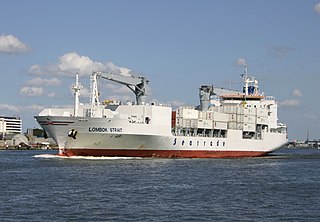
A reefer ship is a refrigerated cargo ship typically used to transport perishable cargo, which require temperature-controlled handling, such as fruits, meat, vegetables, dairy products, and similar items.

Irish stew is a stew native to Ireland that is traditionally made with root vegetables and lamb or mutton, but also commonly with beef. As in all traditional folk dishes, the exact recipe is not consistent from time to time, or place to place. Basic ingredients include lamb, or mutton, as well as potatoes, onions, and parsley. It may sometimes also include carrots. Irish stew is also made with kid.
Irish stew is a celebrated Irish dish, yet its composition is a matter of dispute. Purists maintain that the only acceptable and traditional ingredients are neck mutton chops or kid, potatoes, onions, and water. Others would add such items as carrots, turnips and pearl barley; but the purists maintain that they spoil the true flavour of the dish. The ingredients are boiled and simmered slowly for up to two hours. Salt can be added before or after the cooking. Mutton was the dominant ingredient because the economic importance of sheep lay in their wool and milk produce and this ensured that only old or economically non-viable animals ended up in the cooking pot, where they needed hours of slow cooking. Irish stew is the product of a culinary tradition that relied almost exclusively on cooking over an open fire. It seems that Irish stew was recognised as early as about 1800.
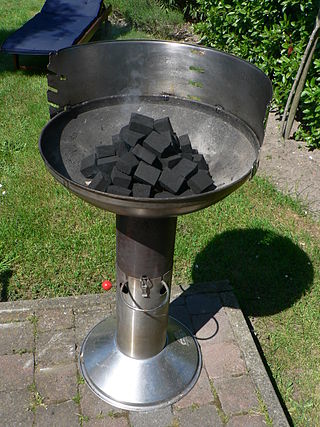
Barbecue varies by the type of meat, sauce, rub, or other flavorings used, the point in barbecuing at which they are added, the role smoke plays, the equipment and fuel used, cooking temperature, and cooking time.

The Romney, formerly called the Romney Marsh sheep but generally referred to by the local farmers as the Kent, is a breed of sheep originating in England. The Romney is a "long-wool" breed recognized in England by 1800. Exported to other continents, the Romney is an economically important sheep breed, especially to the sheep-meat and wool export trades of New Zealand.
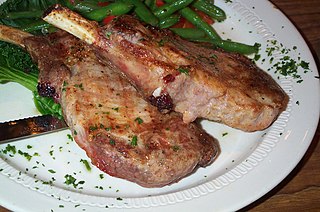
A meat chop is a cut of meat cut perpendicular to the spine, and usually containing a rib or riblet part of a vertebra and served as an individual portion. The most common kinds of meat chops are pork and lamb. A thin boneless chop, or one with only the rib bone, may be called a cutlet, though the difference is not always clear. The term "chop" is not usually used for beef, but a T-bone steak is essentially a loin chop, a rib steak and a rib cutlet.

The Dunedinlisten (help·info) (1876–90) was the first ship to successfully transport a full cargo of refrigerated meat from New Zealand to England. In this capacity, it provided the impetus to develop the capacity of New Zealand as a major provider of agricultural exports, notwithstanding its remoteness from most markets. Dunedin disappeared at sea in 1890, and neither the ship nor her crew has ever been seen or heard from since.
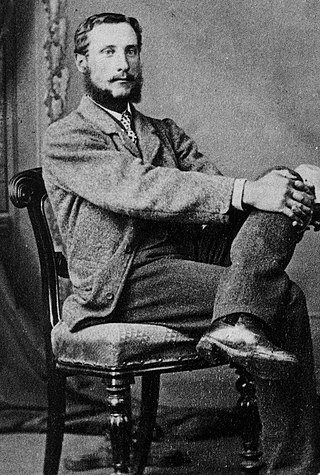
William Soltau Davidson was the New Zealand pioneer of refrigerated shipping.

In New Zealand, agriculture is the largest sector of the tradable economy. The country exported NZ$46.4 billion worth of agricultural products in the 12 months to June 2019, 79.6% of the country's total exported goods. The agriculture, forestry and fisheries sector directly contributed $12.653 billion of the national GDP in the 12 months to September 2020, and employed 143,000 people, 5.9% of New Zealand's workforce, as of the 2018 census.

Meat & Livestock Australia (M&LA) is an independent company which regulates standards for meat and livestock management in Australian and international markets. Headquartered in North Sydney, Australia; M&LA works closely with the Australian government, and the meat and livestock industries. As a multi-faceted authority, M&LA has numerous roles across the financial, public and research sectors. The M&LA corporate group conducts research and offers marketing services to meat producers, government bodies and market analysts alike. Forums and events are also run by M&LA aim to provide producers with the opportunity to engage with other participants in the supply chain.
Thomas Brydone was a New Zealand land-company manager, farm manager and freezing-industry developer.

A steak is a thick cut of meat generally sliced across the muscle fibers, sometimes including a bone. It is normally grilled or fried. Steak can be diced, cooked in sauce, such as in steak and kidney pie, or minced and formed into patties, such as hamburgers.
The New Zealand Meat Board is a statutory body which provides quota management on behalf of the Crown for meat exports to the United States, European Union and United Kingdom. To protect their own livestock industry these countries give limited access to New Zealand meat exports.
New Zealand Refrigerating Company Limited founded 1881 by a committee led by John Roberts killed New Zealand livestock at its Burnside Works built in 1883 in Green Island Dunedin, froze the carcasses and shipped them for wholesaling in Smithfield, London.
Manufacturing in New Zealand contributed $23 billion (12%) of the country's gross domestic product and directly employed 241,000 people in 2017, while manufactured goods made up 52% of the country's exports by value. The food and beverage subsector alone contributed 32% of manufacturing's GDP and 71% of exports.

Gear Meat Company was a meat processing company with a large works that operated in Petone, New Zealand from 1874 until 1981 and was one of the major employers in Petone.
















